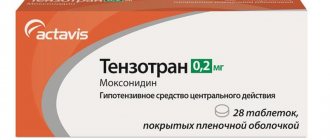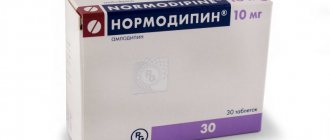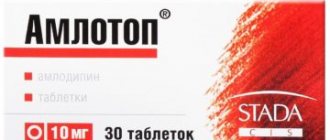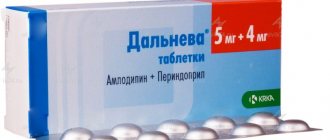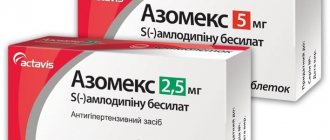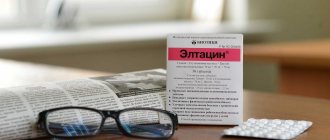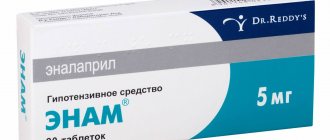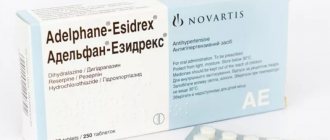Release form and composition
Dosage form of the drug Amlodipine-Prana - tablets: flat-cylindrical, chamfered, color from white to white with a creamy tint, slight marbling may be present; tablets at a dosage of 10 mg - with a dividing line on one side (10 pcs. in blister packs or 40, 50, 60, 70, 80, 90, 100 pcs. in polymer cans; in a cardboard pack 1 can or 1–10 blister packs).
Composition per 1 tablet:
- active substance: amlodipine – 5 or 10 mg (in the form of amlodipine besylate – 6.93 or 13.86 mg, respectively);
- auxiliary components: lactose, corn starch, magnesium stearate, microcrystalline cellulose.
Interaction with alcohol and drugs
Be sure to tell your doctor about the medications you are already taking. Amlodipine-Prana is not advisable to take together with:
calcium channel blockers;- sympathomimetics, estrogens;
- inhalation anesthesia;
- Amiodarone;
- lithium carbonate;
- Orlistat;
- Indomethacin;
- Quinidine.
The drug is not compatible with alcohol, as the effectiveness of the drug is reduced.
Pharmacological properties
Pharmacodynamics
The active component of the drug Amlodipine-Prana is amlodipine, a dihydropyridine derivative, BMCC of the second generation, which has antianginal and antihypertensive effects. Due to binding to dihydropyridine receptors, amlodipine blocks calcium channels, reducing the transmembrane transition of calcium ions into the cell (mainly into vascular smooth muscle cells, to a lesser extent into cardiomyocytes).
The antianginal effectiveness of the substance is due to its dilating effect on the coronary and peripheral arteries and arterioles; in patients with angina pectoris, the severity of ischemia of the heart muscle is reduced. The expansion of peripheral arterioles helps to reduce total peripheral vascular resistance (TPVR), reduces preload on the heart and myocardial oxygen demand. The expansion of the main coronary arteries and arterioles in ischemic and unchanged areas of the myocardium increases the supply of oxygen to the heart muscle (especially in patients with vasospastic angina) and prevents the development of spasm of the coronary arteries (including those caused by smoking). In patients with stable angina, taking a single daily dose of amlodipine increases exercise tolerance, slows down the development of angina and ischemic depression of the ST segment, reduces the frequency of angina attacks and the need for nitroglycerin and other nitrates.
Amlodipine-Prana has a prolonged dose-dependent hypotensive effect due to its direct vasodilating effect on vascular smooth muscle. In patients with arterial hypertension, taking a single dose of amlodipine provides a decrease in blood pressure (BP) by a clinically significant amount within 24 hours, both in the supine and standing positions. Cases of orthostatic hypotension when using amlodipine are quite rare. The drug does not cause a decrease in exercise tolerance and a decrease in left ventricular ejection fraction, and reduces left ventricular myocardial hypertrophy. Amlodipine does not affect the contractility and conductivity of the heart muscle, does not cause a reflex increase in heart rate (HR), inhibits platelet aggregation, potentiates the glomerular filtration rate and has a weak natriuretic effect. In patients with diabetic nephropathy, it does not affect the severity of microalbuminuria. It does not have an adverse effect on the metabolism and concentration of blood plasma lipids; it can be used in the treatment of patients with diabetes mellitus, bronchial asthma, and gout. A significant decrease in blood pressure occurs 6–10 hours after taking the drug, the effect lasts 24 hours.
Pharmacokinetics
Main pharmacokinetic characteristics of amlodipine:
- absorption: amlodipine after oral administration is absorbed from the gastrointestinal tract (GIT) slowly; the average absolute bioavailability is 64%; the maximum concentration (Cmax) in the blood serum is reached 6–9 hours after administration; steady-state serum concentrations (Css) are observed after 7–8 days of regular use; diet and food quality do not have a clinically significant effect on the absorption of the substance;
- distribution: average volume of distribution (Vd) – 21 l/kg body weight, which indicates the distribution of most of the substance in the tissues; a smaller amount of amlodipine entering the blood is 95% bound to plasma proteins;
- metabolism: amlodipine does not have a significant effect of first-pass metabolism (first pass through the liver), it undergoes slow but active hepatic metabolism with the formation of metabolites that do not have significant pharmacological activity;
- elimination: the half-life (T1/2) after a single dose of the drug orally ranges from 31 to 48 hours, with repeated administration the T1/2 indicator is ~ 45 hours; up to 60% of a dose taken orally is eliminated in the urine, mostly in the form of metabolites, up to 10% unchanged; up to 20–25% is excreted through the intestines and breast milk. The total clearance of amlodipine is 0.116 ml/s/kg, or 7 ml/min/kg, or 0.42 l/h/kg.
In elderly patients (over 65 years), the excretion of amlodipine is slower compared to young patients, the T1/2 indicator increases to 65 hours, but this fact is not clinically significant.
In case of liver failure, prolongation of T1/2 (up to 60 hours) suggests that long-term use of amlodipine will increase its accumulation in the body.
Renal failure does not have a significant effect on the pharmacokinetics of the drug. Hemodialysis does not remove amlodipine.
The drug penetrates the blood-brain barrier.
Analogs
Analogues of Amlodipine Prana are: Amlorus, Amlotop, Kalchek, Norvasc, Tenox and many other drugs containing amlodipine. To evaluate the advantages and disadvantages, it is worth considering some of them.
Amlorus belongs to the subgroup of dihydropyridines, a group of calcium channel blockers. The main substance is amlodipine, available in tablets of 2.5 mg, 5 mg and 10 mg. Effectively reduces blood pressure and fights ischemic areas of the myocardium.
Indicated for hypertension of II-III degree, angina pain, chronic heart failure in the stage of decompensation. The initial dose is 5 mg, then the dose is adjusted. The agent is not recommended for:
- pregnancy;
- acquired heart defects;
- in the acute period of MI;
- with caution in elderly people.
Norvasc - the active ingredient is amlodipine, available in 5 mg and 10 mg. Inhibits transmembrane calcium transfer into cardiomyocytes and vascular smooth muscle cells, which provides antihypertensive and anti-ischemic effects.
It is well tolerated by patients; dizziness, malaise, gynecomastia in men, dyspeptic changes, and swelling of the lower extremities are rarely observed. However, the cost of Norvasc is quite high.
Contraindications
Absolute:
- severe hypotension (systolic blood pressure <90 mmHg);
- unstable angina, except Prinzmetal's angina;
- collapse, cardiogenic shock;
- clinically significant aortic stenosis;
- lactase deficiency, lactose intolerance, glucose-galactose malabsorption;
- pregnancy period;
- breastfeeding (lactation);
- children and adolescents under 18 years of age;
- hypersensitivity to dihydropyridine derivatives, including amlodipine and other components of the drug.
Amlodipine-Prana is prescribed with caution to patients with impaired liver function, sick sinus syndrome (with severe bradycardia, tachycardia), chronic heart failure (CHF) of non-ischemic etiology of functional class III–IV according to the NYHA classification, arterial hypotension, aortic stenosis, mitral stenosis, hypertrophic obstructive cardiomyopathy (HOCM), acute myocardial infarction (and within 1 month after it), as well as in old age.
Indications for use
Indications for use of the drug Amlodipine Prana are:
- persistent arterial hypertension newly diagnosed;
- symptomatic hypertension;
- angina pectoris stable and unstable;
- Prinzmetal's angina;
- ischemia of the heart muscle without signs of pain;
- chronic heart failure in the stage of decompensation (as a complex treatment).
Proper nutrition for hypertension
Instructions for use Amlodipine-Prana: method and dosage
Amlodipine-Pran tablets are intended for oral administration.
Recommended dosage:
- arterial hypertension and angina pectoris (treatment): initial dose – 5 mg 1 time per day; maximum dose – 10 mg 1 time per day;
- arterial hypertension (maintenance therapy): dose – 2.5–5 mg (½–1 tablet of 5 mg) 1 time per day.
Due to an increase in T1/2 of amlodipine in elderly patients and a decrease in creatinine clearance (CC), no dose changes are required, but more careful monitoring of the patients' condition is required.
Prescribing Amlodipine-Pran for renal failure, as well as simultaneously with thiazide diuretics, β-blockers and angiotensin-converting enzyme (ACE) inhibitors, does not require dose adjustment.
Patient reviews
The effect of therapy is strictly individual and depends on the condition of the patient’s body. Reviews about the drug Amlodipine Prana:
- A 63-year-old woman with concomitant kidney disease (chronic pyelonephritis) was prescribed Amlodipine. Notes improvement after 5 days. The starting dose was 5 mg, the doctor decided to reduce it to 2.5 mg, due to the manifestation of an undesirable result in the form of headaches and dizziness;
- A 52-year-old man suffers from attacks of heart pain and is diagnosed with coronary artery disease. Stable angina FC II, CH I.” The cardiologist prescribed complex treatment, which included Amlodipine. The patient notes a significant improvement in quality of life.
Independent selection and change of dose is not recommended. An examination by the attending physician is required.
Side effects
Frequency of side effects according to the World Health Organization (WHO) classification (very often - > 0.1; often - > 0.01 and < 0.1; sometimes - > 0.001 and < 0.01; rarely - > 0.0001 and <0.001; extremely rare – <0.0001, including isolated reports):
- cardiovascular system: often - peripheral edema (swelling of the ankles/feet), palpitations, flushing of the face; sometimes – a significant decrease in blood pressure; extremely rarely - loss of consciousness, shortness of breath, orthostatic hypotension, vasculitis, development/worsening of heart failure, heart rhythm disturbances (including bradycardia, ventricular tachycardia and atrial fibrillation), chest pain, myocardial infarction;
- central and peripheral nervous system: often – dizziness, headache, drowsiness, increased fatigue; sometimes - general malaise, asthenia, paresthesia, hypoesthesia, peripheral neuropathy, insomnia, unusual dreams, mood lability, tremor, increased excitability, anxiety, depression; extremely rarely - migraine, hyperhidrosis, apathy;
- digestive system: often – nausea, abdominal pain; sometimes - constipation or diarrhea, vomiting, flatulence, anorexia, dyspepsia, dry mouth, thirst; rarely – increased appetite, gum hyperplasia; extremely rarely - gastritis, pancreatitis, jaundice (a consequence of cholestasis), increased activity of liver transaminases, hyperbilirubinemia, hepatitis;
- hematopoietic organs: extremely rarely - leukopenia, thrombocytopenic purpura, thrombocytopenia;
- genitourinary system: sometimes – nocturia, frequent/painful urination, impotence; extremely rarely - polyuria, dysuria;
- respiratory system: sometimes – rhinitis, shortness of breath; extremely rarely - cough;
- skin and skin: rarely – dermatitis; extremely rarely - alopecia, skin pigmentation disorder, xeroderma, cold sweat;
- hypersensitivity reactions: skin itching, skin rash (including erythematous, maculopapular and urticaria), erythema multiforme, angioedema;
- musculoskeletal system: sometimes – myalgia, arthralgia, muscle cramps, arthrosis, back pain; rarely - myasthenia gravis;
- other reactions: sometimes – diplopia, xerophthalmia, ringing in the ears, disturbance of accommodation, eye pain, conjunctivitis, nosebleeds, chills, gynecomastia; extremely rarely - parosmia, hyperglycemia.
Overdose
Symptoms of amlodipine overdose are excessive peripheral vasodilation with a pronounced and possibly prolonged decrease in blood pressure, collapse and shock.
To treat the condition, it is recommended to perform gastric lavage, take activated charcoal, and take measures to maintain the functioning of the cardiovascular system under the control of indicators of heart and lung function. It is necessary to provide the patient with a horizontal position, raising the lower limbs above the level of the head. It is also necessary to monitor circulating blood volume (CBV) and diuresis. In order to restore vascular tone, vasoconstrictors should be used (in the absence of contraindications), and to eliminate the consequences of calcium channel blockade, calcium gluconate should be administered intravenously. Hemodialysis is ineffective.
special instructions
During therapy, body weight and sodium intake are monitored, and an appropriate diet is prescribed if necessary.
In order to prevent bleeding, pain and hyperplasia of the gums, you should maintain oral hygiene and regularly undergo sanitation by the dentist.
Patients with low body weight, short stature and severe liver dysfunction may require a dose adjustment downward.
Stopping the drug Amlodipine-Prana does not cause withdrawal syndrome, despite this, it is advisable to complete therapy by gradually reducing the dose.
The safety and effectiveness of taking the drug during a hypertensive crisis have not been established.
Impact on the ability to drive vehicles and complex mechanisms
Due to the possible development of adverse reactions such as dizziness and drowsiness at the beginning of treatment, special precautions are required when driving vehicles and performing other types of work that require increased concentration.
Effect on blood pressure
It has been established that Amlodipine-Prana has shown high effectiveness in the fight against hypertension.
Don't tolerate high blood pressure
Now hypertension can be cured by restoring blood vessels...
>
Once in the body, the medicine is absorbed into the gastric mucosa, after which it begins to be absorbed from the gastrointestinal tract into the blood serum, exerting an antihypertensive (BP-lowering) effect on the body.
This is due to the fact that the active substance of the drug acts as follows:
- dilates arteries;
- relaxes the tissues that make up the vessels;
- normalizes blood flow.
The drug gently and fairly quickly lowers both upper and lower blood pressure, while it does not affect the frequency of contractions of the heart muscle and does not cause tachycardia.
The maximum effect is achieved after approximately 4-5 hours and lasts 24 hours, so repeated use during the day is not required.
Drug interactions
- antihypertensive drugs (thiazide diuretics, alpha-blockers, beta-blockers, ACE inhibitors): safe when used together with amlodipine for the treatment of arterial hypertension;
- antianginal agents (long- or short-acting nitrates, beta-blockers): safe when used together with amlodipine for the treatment of stable angina;
- non-steroidal anti-inflammatory drugs (NSAIDs) (especially indomethacin), antibacterial agents and oral hypoglycemic agents: simultaneous use with amlodipine is possible;
- thiazide and loop diuretics, verapamil, ACE inhibitors, beta-blockers, nitrates: may enhance the antianginal and hypotensive effects of BMCC;
- alpha1-blockers, antipsychotics: may enhance the antihypertensive effect of BMCC;
- antiarrhythmic drugs (amiodarone, quinidine): it should be taken into account that some BMCCs may increase the severity of their negative inotropic effect and cause prolongation of the QT interval;
- sildenafil: with a single dose of 100 mg in patients with essential hypertension, the pharmacokinetics of amlodipine are not affected;
- atorvastatin (at a dose of 80 mg): with repeated use with amlodipine (at a dose of 10 mg), no significant changes in the pharmacokinetic parameters of atorvastatin are observed;
- alcohol (drinks containing ethyl alcohol): with single and repeated use with amlodipine (at a dose of 10 mg), the pharmacokinetics of ethanol does not change;
- antiviral drugs (ritonavir): increase plasma concentrations of BMCC, including amlodipine;
- neuroleptics, isoflurane: potentiate the hypotensive effectiveness of dihydropyridine derivatives;
- calcium preparations: can reduce the effect of BMCC;
- lithium preparations: possible increase in manifestations of neurotoxicity (ataxia, nausea/vomiting, diarrhea, tinnitus, tremor);
- cyclosporine: amlodipine does not change its pharmacokinetics;
- Digoxin: amlodipine does not affect its serum concentration and renal clearance;
- warfarin: amlodipine does not have a significant effect on its effectiveness (prothrombin time);
- cimetidine: does not affect the pharmacokinetics of amlodipine;
- digoxin, phenytoin, warfarin, indomethacin: according to in vitro studies, amlodipine does not affect their binding to blood proteins;
- grapefruit juice: with simultaneous single oral administration of amlodipine (at a dose of 10 mg) and 240 ml of grapefruit juice, no significant changes in the pharmacokinetics of amlodipine were observed.
